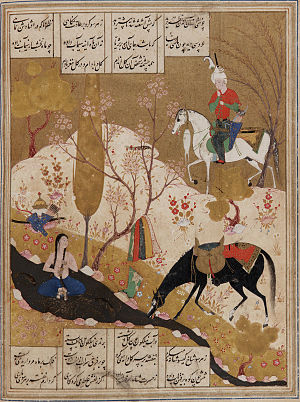Hakim Nizami, a famous Persian-speaking poet
Like Ferdowsi and Sa’di, Nezami was not only able to create and perfect a special style and method of his own but also had an influence on Persian poets who came after him. Nezami had a wide range of knowledge of the common sciences of his time (such as literary sciences, astronomy, Islamic sciences, jurisprudence, theology, and Arabic language) and this feature can be clearly witnessed in his poetry.

Hakim Nizami, a famous Persian-speaking poet
Jamal al-Din Abu Muḥammad Ilyas ibn Yusuf ibn-Zakki, popularly known as Nezami Ganjavi and Hakim Nezami, was a 12th-century Muslim poet and is considered the greatest romantic epic poet in Persian literature who brought a colloquial and realistic style to the Persian epic.
Like Ferdowsi and Sa’di, Nezami was not only able to create and perfect a special style and method of his own but also had an influence on Persian poets who came after him. Nezami had a wide range of knowledge of the common sciences of his time (such as literary sciences, astronomy, Islamic sciences, jurisprudence, theology, and Arabic language) and this feature can be clearly witnessed in his poetry.
He was very particular in selecting appropriate words and phrases, creating new and innovative combinations, inventing new and pleasant meanings and themes, depicting details with the power of his imagination, describing landscapes and describing nature and people, and using pleasant and new similes and metaphors, which ranks him among those who were unparalleled in comparison to those poets who came after him.
The famous and unparalleled masterpiece left behind by Nezami is “Khamseh or Panj Ganj” (Five Treasures) is a lofty work in the realm of lyrical stories and he should, therefore, be considered the pioneer of such type of poetry in Persian literature. Nezami had spent thirty years of his life arranging and compiling his poetry. Khamseh or Panj Ganj (five treasures) comprises five Mathnavis of “Makhzan al-Asrar” (one of the prominent examples of educational literature in the Persian language), Khosrow and Shirin (the love story of Khosrow Parviz, the great king of the Sassanid Empire and the Armenian prince, Shirin), Leily va Majnun (the most famous classic love story of Persian literature), Haft Peykar (also called Bahramnameh and Haft Gonbad), and Eskandarnameh (consisting of Eqbalnameh and Sharafnameh).
Divan of Poems and Ghazals (a collection of poems, odes, quatrains, couplets, passages, scattered verses, and ghazals on various moral, mystical, and social subjects) and the seventh book of Khamseh or Ganjeh-ye Ganjavi (consisting of odes, ghazals, pieces, and quatrains), too, are some of his other works. The use of Gnostic and logical concepts has given the mysterious aspect to his poems that leads the reader to think more deeply. In his works, one can see the numerous metaphors, deep thoughts, secrets, and passions. Nizami with his inspiration of the Iranian world, both before and after the arrival of Islam, succeeded in giving a sense of unity to the civilization of Iran.
So far, many international meetings, congresses, etc. have been held in Iran and the world to commemorate Nezami Ganjavi. March 12 has been named as “Nezami Ganjavi Commemoration Day” in the official Iranian calendar. In addition to Iran, Nezami’s statues can be found in China, Azerbaijan, Italy, etc.
Nezami Ganjavi passed away in his birthplace of Ganja in the year 1209 CE and there is a tomb in that city, which is believed to be Nezami’s.
It is clearly evident that in terms of cultural orientation, cultural background, legacy, myth, folklore, and language, Nizami Ganjavi is part of Iranian civilization and a prominent of Persian cultural history.
